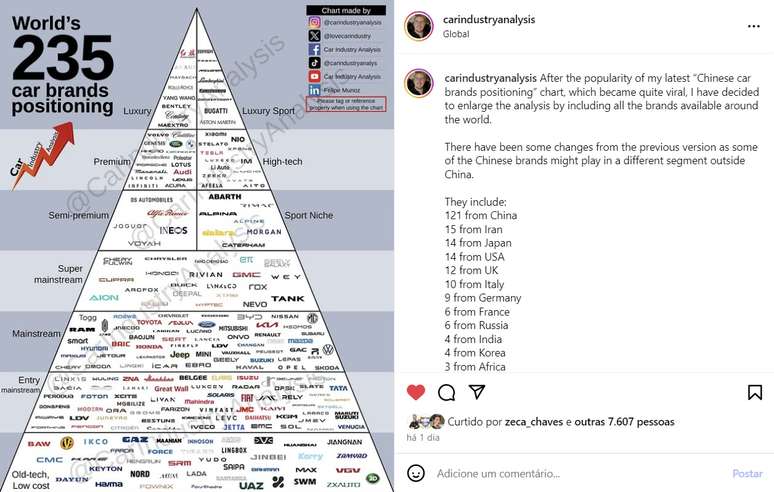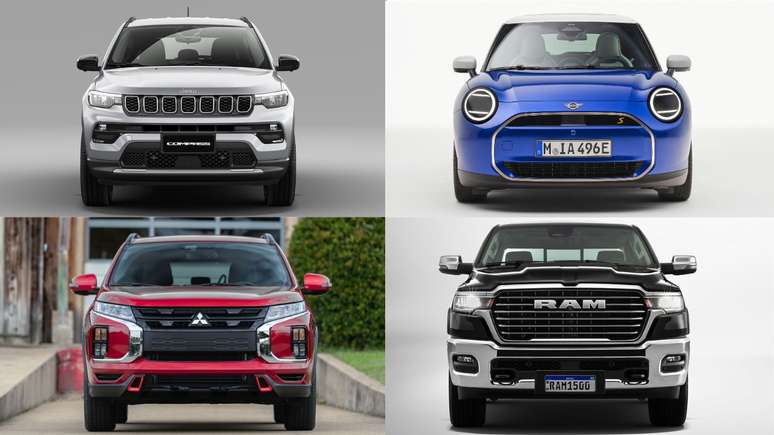The study reveals how car manufacturers position themselves around the world; Fiat and Citroën, for example, do not fall into the same category as Volkswagen and Renault
Not all brands are as premium as you think or as they want you to think. The new study by Felipe Munoz, profile analyst Analysis of the automotive sectorreveals a global hierarchy of automakers that places each in its rightful place, from the absolute luxury elite to the popular entry-level. And the result may surprise many.
After all, Fiat and Citroën are not on the same level as Volkswagen and Renault, for example. Just like BYD, Chery and Haval have not yet reached the level of sophistication of Zeekr, the luxury and high-tech division of the Geely group. And, finally, Tank, a brand of the Chinese GWM group, appears above Jeep, which gives a good idea of how the global market is changing.
Another example: if in Brazil Ram tries to position itself as a “premium brand”, at the level of Audi, BMW or Mercedes, in the ranking of the famous specialist Felipe Munoz, Ram is at the same level as Jaecoo, Nissan and Peugeot, as well as Ford and Chevrolet. In the ranking below we highlight the brands present in Brazil in bold.
Global car brand pyramid: from luxury to popular

A – Luxury and Sports Luxury
- Luxury: Bentley, Maybach, Rolls-RoyceYangwang
- Sporty luxury: Aston MartinBugatti, FerrariKoenigsegg, Lamborghinis, McLarenPagans
At the top of the pyramid are brands that combine exclusivity, performance and status. These are the brands that make cars for billionaires – symbols of power and opulence, with artisanal production and prices easily exceeding millions. Therefore Ferrari and not Porsche are not competitors.
B – Premium and high technology
- Prize: Audi, BMWCadillac, Genesis, Land Rover, LexusLincoln, Maserati, Mercedes-Benz, Porsche, Volvo
- High tech: Avatr, Li Auto, Nio, Tesla, Xpeng, Xiaomi, Zeekr
Premium brands represent tradition and modern luxury, while high tech symbolizes new technological prestige: electric, connected and minimalist. In this scenario, Zeekr emerges as the most advanced among Chinese companies, rivaling Tesla and overtaking already established names in the segment, such as BYD.
C – Semipremium and sports niche
- Semi-prize: Alfa Romeo, DS, Jaguar
- Sports niche: AbarthAlpino, Morgan, Rimac
Here are the brands that focus on emotion and design, with loyal audiences and smaller volumes. The semi-premium ones, such as Alfa Romeo and DS, mix elegance and sportiness, while the niche sports cars – Abarth, Alpine, Morgan and Rimac – ensure performance and exclusivity in limited production. According to Felipe Munoz, Alfa Romeo and Jaguar were relegated because their future was threatened.
D – Populares Superiores (Mainstream Super)
- AioneBuick, Exeed, Tank, HyperLynk&Co, HeyChrysler
Among the most popular premium brands, new Chinese brands of increasing quality stand out – such as Aion (GAC) and Tank (GWM) – which surpass traditional names such as Chrysler and Buick in terms of finishes and technology. They show how China is redefining the concept of the medium car with more luxury and refinement. Wey debuts this month in Brazil as GWM’s new “luxury” brand; but it is not a luxury, as we can see.
E – Popular (mainstream)
- Baojun, BYDChang’an, Chery, ChevroletDodge, Ford, GAC, Geely, Haval, Honda, Hyundai, jaecoo, Jeeps, KiaLancia, Mazda, Maximum, MG, Mini, Mitsubishi, Nissan, OmodaOpel, Peugeot, Ram, Renault,Skoda,Smart, Subaru, Suzuki, Toyota, Volkswagen
This is the heart of the global market: the most popular and accessible brands, present on all continents. Here are giants like Toyota, Volkswagen, Honda and Chevrolet, side by side with emerging Chinese companies like BYD, Chery, Omoda and Haval. It is the most competitive track on the planet, where tradition and innovation meet. But understand, Mini, Jeep and Ram are not premium brands.
F – Popular Voice (Mainstream Voice)
- CitroënDacia, Daihatsu, Photon, FiatGreat Wall, Iveco, JACMahindra, NowSeres, Isuzu, Tata
Entry-level brands prioritize cost-effectiveness and simplicity. It should be noted that Ora, GWM’s electricity division, is still at this level, below Haval itself, which shows how the Chinese group has very different divisions in terms of proposition and price. Fiat and Citroën also appear here, on the same level as JAC, reinforcing their focus on urban and affordable cars. And this is not a demerit, just look at the success of the glorious Fiat, number 1 brand in Brazil, unbeatable in the national market.
G – Low cost and old technology
- JinbeiLada
At the base of the pyramid are brands aimed at emerging markets, with simple, low-priced vehicles. They are the most convenient options, but also the furthest in terms of technology and comfort. Russian Lada, for example, has already achieved great success in Brazil with the 4×4 SUV Niva, a true “small tractor”.
A new global order
Felipe Munoz’s study makes it clear that the prestige of brands is not just a question of tradition. The Chinese are advancing rapidly, occupying positions previously dominated by Europeans, Japanese, Koreans and Americans. Meanwhile, established brands are trying to reinvent themselves in an increasingly technological and competitive scenario.
In short: the automotive world is rearranging itself – and maybe that brand you thought was “luxury” is, in reality, just “popular with good marketing.”
Source: Automotive Industry Analysis
Source: Terra
Rose James is a Gossipify movie and series reviewer known for her in-depth analysis and unique perspective on the latest releases. With a background in film studies, she provides engaging and informative reviews, and keeps readers up to date with industry trends and emerging talents.







